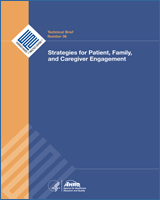NCBI Bookshelf. A service of the National Library of Medicine, National Institutes of Health.
Bennett WL, Pitts S, Aboumatar H, et al. Strategies for Patient, Family, and Caregiver Engagement [Internet]. Rockville (MD): Agency for Healthcare Research and Quality (US); 2020 Aug. (Technical Brief, No. 36.)
We addressed Guiding Question 1 through literature review and discussion with Key Informants. We conducted a systematic literature search to identify systematic reviews on patient engagement strategies for chronic conditions. Guiding Question 2 was informed by the findings from Guiding Question 1.
Discussions With Key Informants
Key Informants were selected for their specific perspectives, including caregivers, patient representatives (e.g., from the Institute for Patient- and Family-Centered Care), health system leaders, primary care providers, nurses, payers (e.g., from Anthem, Inc.), and researchers testing patient and family engagement strategies. We solicited input on what to emphasize in the methodologic approach to the Technical Brief (e.g., strategies, methods, outcomes) and what is most important from each of their perspectives. We asked Key Informants to share their perspectives on topics that pertain to patient and family engagement and the Guiding Questions. These interviews allowed us to characterize different engagement strategies that may not appear in either the gray or published literature.
We developed interview guides, separate for each type of Key Informant, as appropriate. Box 1 lists the full set of Key Informant interview questions.
Box 1Key Informant interview questions
From your experience or clinical practice, please identify an example of a patient, family or family engagement strategy.
We will ask you to discuss this strategy on the call and consider some of these aspects of the strategy:
- Who/what was the focus?
- What was the setting? Who was involved?
- Was it successful - why or why not?
- What contributed to it being successful or not?
Call 1: Word Cloud Brainstorm as a tool to enhance discussion: please share your words/phrases on what you think is most important to measure and know about whether a patient, family and caregiver engagement strategy is working (such as patient satisfaction, better quality of care, etc.).
Call 2: Word Cloud Brainstorm as a tool to enhance discussion: please share your words/phrases on some of the challenges that exist to implement patient, family and caregiver engagement strategies into the health system (such as costs, or lack of evidence of what works best).
We conducted interviews in small groups on the telephone. Notes were drafted for each call. Calls were recorded to assist with ensuring complete and accurate documentation.
Published Literature Search
We defined the criteria for inclusion in the review of published literature, using the PICOTS framework (Population, Intervention, Comparison, Outcomes, Timing, and Setting). Table 1 lists the eligibility criteria.
Table 1
Inclusion and exclusion criteria.
Search, Study Selection, and Data Abstraction
Our search strategies are in Appendix A. We first searched PubMed and CINAHL from January 2015 through January 2020 to identify systematic reviews. Due to the large volume of published studies, we focused on reviews published since January 2015, which would capture original articles published prior to 2015. Once we identified systematic reviews, we augmented the search by using the same search strategy (i.e., January 2015 through January 2020 using PubMed and CINAHL) to identify relevant original studies that might not have been included in the systematic reviews.
Search results were screened first at the abstract level, and then at the full-text level using the same relevant inclusion criteria. We selected original articles that focused on health system and community/policy level engagement strategies, where we had identified gaps in the search for reviews. We updated the search while the Technical Brief was posted for public comment.
Search results were screened independently by two team members, first at the abstract level, and then at the full-text level. We abstracted author, publication year, end search dates, and number and type of included studies, populations, interventions, outcomes, results, and findings from each eligible systematic review. We used the term modality to describe the interventions with regard to how they are being delivered and by whom, with categories of technology (e.g. telehealth, m health, patient portal), peer/lay support, community health worker/patient navigator, nurse/case managers, team based care, and other options (as specified). These categories were chosen based on expert input on features of commonly tested interventions. The team summarized the findings from the systematic reviews based on the assessment by the reviews’ authors in their conclusions. The conclusions and degree of benefit was categorized as the following: No benefit, Unclear Benefit (mix of both positive and no or unclear benefit studies), potential (more positive studies than and no or unclear benefit studies) and positive benefit (most studies showed positive benefits in most outcomes). One reviewer categorized the conclusions and they were verified by a second reviewer.
Gray Literature
We designed the gray literature search to identify reports on health care organization/system and community strategies that might fill in gaps not covered by the published literature. We targeted the gray literature search on reports from national organizations, including the Patient Centered Outcomes Research Institute (PCORI), the Institute for Patient- and Family-Centered Care, the Institute for Healthcare Improvement, and governmental agencies such as AHRQ and the National Institute of Nursing Research, as well as information received from our Key Informants. No materials were submitted through the Supplemental Evidence and Data for Systematic Reviews (SEADS) portal.
- Methods - Strategies for Patient, Family, and Caregiver EngagementMethods - Strategies for Patient, Family, and Caregiver Engagement
- probable G-protein coupled receptor 19 isoform X2 [Homo sapiens]probable G-protein coupled receptor 19 isoform X2 [Homo sapiens]gi|2462531529|ref|XP_054227827.1|Protein
- UNVERIFIED: Correlophus ciliatus mitochondrion sequenceUNVERIFIED: Correlophus ciliatus mitochondrion sequencegi|2543984519|gb|OP320472.1|Nucleotide
- Correlophus ciliatus voucher TG2301 protein tyrosine phosphatase nonreceptor typ...Correlophus ciliatus voucher TG2301 protein tyrosine phosphatase nonreceptor type 12 (PTPN12) gene, partial cdsgi|2522764101|gb|OP274064.1|Nucleotide
- protein CBFA2T1 isoform A [Homo sapiens]protein CBFA2T1 isoform A [Homo sapiens]gi|4757916|ref|NP_004340.1|Protein
Your browsing activity is empty.
Activity recording is turned off.
See more...
